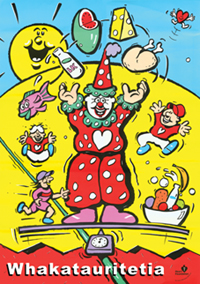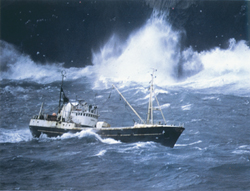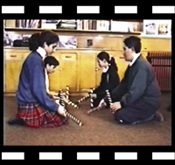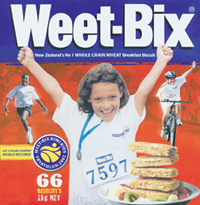Acknowledgments
The
Project directors acknowledge the vital support and contributions
of many people to this report, including:
- the very
dedicated staff of the Educational Assessment Research Unit
- Lisa Rodgers
and other staff members of the Ministry of Education
- members of
the Project’s National Advisory Committee
- members of
the Project’s Mäori Immersion Education Advisory Committee
and Mäori Reference Group
- members
of the Project’s Literacy Advisory Panel, English Language
Advisory Panel, Health and Physical Education Advisory Panel
- principals
and children of the schools where tasks were trialled
- principals,
staff, and Board of Trustee members of the 283 schools included
in the 2002 sample
- the 3137
children who participated in the assessments and their parents
- the 107
teachers who administered the assessments to the children
- the 44 senior
tertiary students who assisted with the marking process
- the 204
teachers who assisted with the marking of tasks early in 2003
| |
The
following Summary is presented in English; for the Mäori
translation
Press Here |
| |
New Zealand’s National
Education Monitoring Project commenced in 1993, with the task of assessing
and reporting on the achievement of New Zealand primary school children
in all areas of the school curriculum. Children are assessed at two
class levels: year 4 (halfway through primary education) and year
8 (at the end of primary education). Different curriculum areas and
skills are assessed each year, over a four-year cycle. In 2002, the
areas covered were writing, listening, viewing, health and physical
education.
The main
goal of national monitoring is to provide detailed information
about what children can do so that patterns of performance
can be recognised, successes celebrated, and desirable changes
to educational practices and resources identified and implemented.
Each year, small random samples of children are selected nationally,
then assessed in their own schools by teachers specially seconded
and trained for this work. Task instructions are given orally
by teachers, through video presentations, on laptop computers,
or in writing. Many of the assessment tasks involve the children
in the use of equipment and supplies. Their responses are
presented orally, by demonstration, in writing, in computer
files, or through submission of other physical products. Many
of the responses are recorded on videotape for subsequent
analysis.
|
|
This report focuses solely on year 8 students. Starting in 1999, assessments
of students learning in Mäori immersion programmes were added
to the national monitoring programme, at the year 8 level only. In
2002, about 60 percent of these Mäori immersion students were
learning in immersion schools (mainly Kura Kaupapa Mäori), while
the other 40 percent were learning in immersion classes (located in
mainstream schools, but having 80 to 100 percent of instruction conducted
in Mäori). For this special sample of students learning predominantly
in Mäori, the assessment tasks and task materials were translated
into Mäori and administered by teachers experienced in Mäori
immersion settings. The results these students achieved are reported
here, together with comparative figures for Mäori students in
the main year 8 national monitoring sample (whose schooling was conducted
predominantly in English).
Chapter
1 explains key features of the National Education Monitoring Project
that are relevant to this report.
Chapter
2 explains some issues affecting the interpretation of the assessments
in Mäori immersion settings, and especially the comparisons of
the achievements of Mäori students in general education and Mäori
immersion programmes.
One issue involved the translation of task instructions and materials
from English to Mäori. While this was done with considerable
care by a team of seven experienced people, some of the resulting
translations may have used vocabulary or language structures that
would not have been easy for all immersion students to understand.
To some extent this is exacerbated because the various Mäori
curriculum documents are quite new, but it will always remain a challenge
to find natural language in both English and Mäori that communicates
exactly the same task requirements.
A related issue is that some of the students in Mäori immersion
settings had not yet developed sufficient skills in te reo Mäori
to fully understand task instructions or to communicate their responses
well. The selected Mäori immersion schools were asked to indicate
which of their students had completed more than four years of immersion
education, and national monitoring samples were selected from these
experienced students. Nevertheless, some of the selected students
still struggled at times with communication in Mäori.
Other important issues affecting interpretation of the results are
the different curriculum emphases in Mäori immersion schools
and classes and the often limited availability of suitable resources
for their teaching and learning programmes. Because curriculum priorities
are different for Mäori immersion education than for general
education, patterns of achievement can be expected to differ accordingly.
Also, Mäori immersion education is in an early stage of development.
Many immersion schools and classes have been established for only
a few years. Teaching and learning resources in te reo Mäori
are scarce, as are teachers with suitable expertise. High levels of
teacher, parent and student commitment help to compensate for these
obstacles to successful learning, but further improvement can be anticipated
as Mäori immersion education grows and consolidates.
|
|
Chapter
3 presents the results of the assessments of students’
knowledge
and skills in writing. Writing is an important means of communication.
Through their writing, people communicate feelings, ideas and
information to other people, for a wide range of purposes. Expressive
writing allows considerable scope for inventiveness, and requires
skills such as writing coherently, communicating personal feeling,
communicating stories or ideas vividly, and following the conventions
associated with particular forms of writing. Functional writing
involves presenting information clearly and accurately in written
form to describe events, give instructions, promote events or
products, fill in forms, and communicate information to other
people through letters, postcards, email messages and text messages.
|
Mäori students
in general education and students in Mäori immersion settings performed
equally well on eleven of the sixteen writing tasks. Mäori students
in general education scored statistically significantly higher on two
tasks, and students in Mäori immersion settings scored statistically
significantly higher on three tasks.
Chapter 4 presents the results of the
assessments of students’ skills in listening. Listening is an
important skill. Good listening is required for a wide variety of
purposes, such as participating in conversations, understanding stories,
obtaining information, identifying opinions or viewpoints, enjoying
entertainments or events, and extending personal language knowledge
and skills.
Mäori students in general education scored statistically significantly
higher than students in Mäori immersion settings on all ten listening
tasks.
Chapter 5 presents the results of the
assessments of students’ knowledge and skills in viewing. Visual
messages are prominent in today’s world. Some, like advertisements,
are intended to persuade. Some are designed to entertain, or to trigger
emotional responses. Many messages designed to communicate information
rely heavily on visual information to complement text components. Visual
messages are also an important part of interpersonal communication,
through the non-verbal signals in facial expressions, gestures and other
behaviours. Understanding visual messages is therefore an important
educational goal.
| Mäori
students in general education and students in Mäori immersion
settings performed equally well on six of the ten viewing tasks.
Mäori students in general education scored statistically
significantly higher on two tasks, and students in Mäori
immersion settings scored statistically significantly higher on
two tasks. |
|
Chapter 6 presents the results of the
assessments of students’ knowledge, understandings and skills
in health. Health education is intended to help students develop knowledge,
understandings and skills in three broad areas that are important
to individual and community well-being:
• maintaining and
enhancing personal health and physical development;
• interacting and
relating effectively with other people; and
• participating in
creating healthy communities and environments through responsible
and critical
action.
Mäori students in general education and students in Mäori
immersion settings performed equally well on nineteen of the twenty-eight
health tasks. Mäori students in general education scored statistically
significantly higher on one task, and students in Mäori immersion
settings performed statistically significantly higher on eight tasks.
|
CHAPTER 7: PHYSICAL EDUCATION |
|
Chapter
7 presents the results of the assessments of students’
skills in physical education. Physical education focuses on the
development of personal movement skills and other capabilities
appropriate to a wide range of situations and environments. These
skills play an important role in carrying out daily routines,
performing employment tasks and participating effectively in recreational
and sporting activities.
Mäori students in general education and students in Mäori
immersion settings performed equally well on thirteen of the sixteen
physical education tasks. Mäori students in general education
scored statistically significantly higher on one task, and students
in Mäori immersion settings performed statistically significantly
higher on two tasks. |
Chapter 8 reports the results of surveys
of students about their curriculum preferences and their perceptions
of their achievement and potential in writing, health education and
physical education.
The students were asked to select their three favourite school subjects
from a list of twelve subjects. Physical education was the top, or
top-equal, choice for both groups, while health was lowest for Mäori
students in general education and ninth of the twelve subjects for
students in Mäori immersion settings. Writing was second last
for both groups, and listening and viewing were not included in the
list of twelve subjects. Compared to Mäori students in general
education, students in Mäori immersion settings rated mathematics,
science and reading substantially higher, and physical education,
technology and music substantially lower.
Asked what “people need to do to be good writers”, students
could choose up to three things from a list of ten. Compared to Mäori
students in general education, students in Mäori immersion settings
chose use their imagination much less and write neatly
and talk about their work with others much more. Students
were also asked to write down what they needed to do to “get
better in writing”. Compared to Mäori students in general
education, students in Mäori immersion settings placed greater
emphasis on improving their editing and checking, their neatness,
and how often they wrote, and less emphasis on improving their spelling.
There were also fifteen rating items in the writing survey. Compared
to Mäori students in general education, students in Mäori
immersion settings:
• were much
more positive about writing at school;
• felt that
their parents were more positive about their writing ability;
• thought that
they were better at spelling (in Mäori, rather than English);
• read their
writing to friends more often;
• used computers
for writing much more often, both at school and at home.
In
the health education survey, students were presented with a list
of thirteen health activities and asked which they liked or disliked
doing most at school. Compared to Mäori students in general
education, students in Mäori immersion settings were dramatically
less enthusiastic about how to keep safe, and substantially
less enthusiastic about foods and healthy eating, but
substantially more enthusiastic about how to care for myself,
how to care for others, and how to get on with others.
There were four rating items in the health education survey. Compared
to Mäori students in general education, students in Mäori
immersion settings reported more class work that helped them to
learn about health, were somewhat less enthusiastic about its
value, but were substantially more enthusiastic about continuing
to learn or do more health education as they got older. |
|
The students
were presented with a list of seven activities that they might do
in physical education at school. Compared to Mäori students in
general education, students in Mäori immersion setting were similarly
and highly enthusiastic about ball activities, dramatically less enthusiastic
about athletics, substantially more enthusiastic about swimming, and
somewhat more enthusiastic about gymnastics, dance and te reo kori.
When asked to write down up to three very important things a person
needs to learn or do to be good in physical education, Mäori
students in general education emphasized fitness most, followed by
three almost equally popular options: good sportsmanship, positive
attitudes and effort, and physical or game skills. Students in Mäori
immersion settings emphasized physical or game skills most, followed
in order by training/practising, fitness, and good sportsmanship.
In total, across
all five areas reported here, Mäori students in general education
performed better on 20 percent of the tasks, students in Mäori
immersion settings performed better on 19 percent of the tasks, and
there was no difference on 61 percent of the tasks.
This overall pattern also applied in three of the five areas: writing,
viewing and health. In the other two areas, however, the patterns
were different. Mäori students in general education performed
better than students in Mäori immersion settings on all ten listening
tasks. Conversely, students in Mäori immersion settings performed
better on 29 percent of the health tasks while Mäori students
in general education performed better on just 3 percent of these tasks.
|




